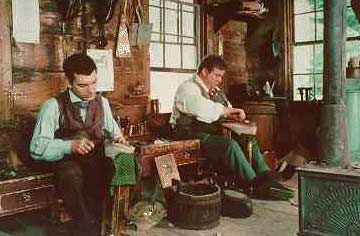

Village Boot-Shop - $$3.95
In the 1830s, Boot and Shoe making was an expanding industry and a young man's trade. The vast majority of shoemakers were under the age of 30 and earned 25 cents for completing the production of a pair of shoes. The manufacturing system for making large quantities of shoes developed in eastern Massachusetts in the late 18th century and then was adopted in many parts of the New England countryside.
Old Sturbridge
Village, MA - Shoe Shop and Boot Shop

This lovely high resolution and framable watercolor
of the Boot Makers Shop,
by our artist Derek Carter, is included with your model. Print
to any size
In the 1830s, Boot and Shoe making was an expanding industry and a young man's trade. The vast majority of shoemakers were under the age of 30 and earned 25 cents for completing the production of a pair of shoes. The manufacturing system for making large quantities of shoes developed in eastern Massachusetts in the late 18th century and then was adopted in many parts of the New England countryside.
Below are a few photos of different perspectives of this adorable little building. |
  |
|
The boot shop is great! It's almost like Christmas when the FG e-mail comes. Glad to see buildings once more...you'll make my grandson's train layout happy.
 Modeln Pal, Joe Massey sends in these photos of his Old Sturbridge Village Boot Shop model (front and rear). Look how much a little landscaping adds to the model !! Better still!! Joe has added a layer of window and door frames giving it a 'lived in' feel. This is just one part of the Fiddlersgreen downloadable New England Village... Thanx Joe Great job! |
 |
I started up working on the New England buildings with the little Boot Shop. I also used some of my old landscaping materials, I grubbed around through the lockers and found it all where I had left it last. I posted it up for all to see on the forum site with my usual blow by blow accounting. Here are a couple of pictures for you. Joe
 When
you look into this little ‘10 by 10’ shop you’ll
see traditional low-seated shoemaker's benches, as well as a "stand-up"
bench. Tools of the 17th Centure Shoemaker were awls, knives, punches,
bristles, waxes, threads, needles, and wooden pegs.
When
you look into this little ‘10 by 10’ shop you’ll
see traditional low-seated shoemaker's benches, as well as a "stand-up"
bench. Tools of the 17th Centure Shoemaker were awls, knives, punches,
bristles, waxes, threads, needles, and wooden pegs. Shoemaking took place in small country shops and homes and depended almost completely upon handwork. By the 1830s these small shops were, by the thousands, producing shoes for the wholesale trade and shipping shoes to markets far and wide. In Massachusetts, alone, more people were employed in shoemaking than in any occupation besides farming. Approximately twenty-three thousand men and fifteen thousand women, mostly rural, were working at the shoe and boot trade in 18 37, producing 1 million pairs of shoes and 1.5 million pairs of boots.

Women and girls usually worked at hand sewing together the shoe "uppers" in their homes, while men did the heavier work of "bottoming," (attaching the soles and heels). The men sometimes worked at home, but more often in small, "ten-footer" shoe shops that became common features of the rural landscape.
Most shoemakers were under the age of thirty, and virtually all under forty. Many a son of a struggling farmer took to stitching and pegging shoes. Shoemakers were paid a cash wage and a steady worker bottoming shoes could average seventy-five cents a day, comfortably more than farm labor paid. The trade was so attractive to young men that farmers were becoming worried about a shortage of manual help.



